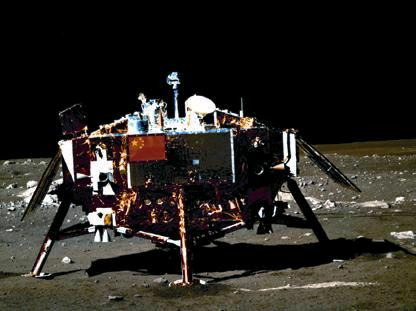China Takes Next Step Toward Lunar Industrial development
2014-03-11

The successful December 14 landing of Chinas Change-3 spacecraft on the Moon, and deployment a few hours later of the Yutu (Jade Rabbit) lunar rover, have laid the basis for its long-term goal of the industrial development of the Moon. Following the success of the first two Change-3 missions, which orbited the Moon, the current mission provides the on-the-ground intensive exploration that will lead to manned missions in the future.
Chinas lunar exploration program, which has been under development for more than a decade, is aimed first at the scientific investigation of Earths nearest neighbor, and at taking an inventory of resources on the Moon. Eventually, missions will exploit the riches there, which are not gold or silver, but minerals which include a rare isotope of helium, which could power the thermonuclear fusion-energy-based economy of the future.
China is not “competing” with any other nation in its lunar exploration program. Contrary to press commentary, it is merely following a multi-decade succession of increasingly complex missions. Each mission tests new capabilities aimed at meeting its long-term goals. The challenging Change-3 mission was the first time that China landed a spacecraft on another celestial body. It was the first time that any nation carried out its first extraterrestrial landing which included the deployment of a rover.
The success of the Change-3 mission has given Chinas space leadership the confidence to accelerate its next phase in lunar exploration, including the announcement that returning a sample of rock and soil from the Moon to Earth will take place only three years from now.
Whats new
In designing the Change-3 mission, China had no intention of simply repeating the lunar missions that were carried out by the United States and the former Soviet Union nearly 40 years ago. The Yutu rover will, for the first time, use an on-board radar instrument to probe the subsurface of the Moon. Exploring the inner structure of the lifeless Moon with precision, down to a depth of 90 feet, will shed light on the development not only of this body, but of the Solar System as a whole.
The Change-3 lander houses an ultraviolet telescope, a Moon-based “cosmic observatory,” which will conduct astronomical observations from the surface of the Moon for the first time. A second ultraviolet instrument will study the Earths ionosphere.
The rover, with a robotic arm similar to that on NASAs Curiosity Mars rover, will deploy instruments to describe the chemical and mineralogical composition of rocks on the Moon. On January 3, the Chinese Academys Institute of High Energy Physics released to the world scientific community the first data obtained by the rover.endprint
The institute posted on its website an initial analysis of data from the rovers Active Particleinduced X-ray Spectrometer (APXS), which can identify the chemical elements in the lunar soil. The data indicate the presence of eight of the expected major rockforming elements, and at least three minor elements. While these first results were not unexpected, they demonstrated that the instrument is working as designed. The release of the data and analysis to the public is an important policy decision by China, because it engages the global scientific community with the mission.
APXS was first powered up on December 23, and two days later was deployed to a position slightly above the lunar surface by the robotic arm, to go into its detection mode. Chinese scientists are pleased with the instruments performance, and the institute says this is one of the best X-ray spectrometers deployed on a planetary mission.
Both the Change-3 lander and the Yutu rover depend upon solar energy for their power, and so, hibernate during the twoweek lunar night. Yutu is expected to awake to resume its three-month scientific mission on the lunar surface.
Looking ahead
Although there has been no formal government decision on developing manned lunar missions, Chinese scientists and engineers are working on designs for a lunar base, which will include“new energy development,”according to Zhang Yuhua, a manager of Change-3, speaking at the Shanghai Science Communication Forum, as reported January 8 in Peoples Daily.
Zhang described the activity of a lunar base as setting up agricultural and industrial production, producing medicines in the vacuum environment, and carrying out “energy reconnaissance.” The most oftcited lunar energy resource by Chinese scientists is the isotope helium-3, which is rare on Earth, but has remained largely undisturbed on the inert lunar surface, having been deposited there by the Sun. This al
lows a more advanced form of fusion energy, enabling many applications in energy, industry, and chemistry, and will provide power on both the Moon and the Earth.
Fusion on the Moon has been part of Chinas program since its inception. Ten years ago, speaking before the 12th conference of the Chinese Academy of Sciences, the scientist known as the “father” of Chinas lunar missions, Ouyang Ziyuan, described his nations three-step lunar robotic program, stating that it should scout and map mineralogical elements, including helium-3.endprint
More recently, Ouyang explained that“there are altogether 15 tons of helium-3 on Earth, while on the Moon, the total amount can reach 1 million to 5 million tons. Helium-3 is considered as a long-term, stable, safe, clean, and cheap material for human beings to get nuclear energy through controllable nuclear fusion experiments. This means that the helium-3 reserves on the Moon can serve human society for at least 10,000 years.” The goal, he has said, is to “bring enough fuel for all human beings across the world” from the Moon.
Chinese scientists are also conducting a series of experiments to grow a variety of basic crops under a simulated lunar environment. The Tiangong-1 laboratory, staffed by scientists from Beijing University of Aeronautics and Astronautics, hosts experiments in growing food that replicate lunar conditions.
The team, which is headed by Professor Liu Hong, has done tests on more than 10 plant varieties, controlling the food, water, oxygen, and soil chemistry of the environment. They are also investigating plants with a strong resistance to space radiation. The technologies developed through this and similar programs will also be important for Chinas next step in manned space flight—its space station.
Then, JFK—now, China
It is difficult for some to understand why China, a still-developing nation, is deploying precious resources to explore the Moon. Comments made by Chinese President Xi Jinping on January 7, to the space scientists and engineers who participated in the research and development of the Change-3 mission, should shed some light on the matter. As reported by Xinhua News Agency, Xi said that innovations in science and technology must be put in a “core position” in the countrys overall development.
Innovation is “the soul of a people and the source for a countrys prosperity,” Xi said, going on to emphasize that the Change-3 mission was ‘China-made in every sense of the phrase.
That was the outlook of the United States under President John F. Kennedy, an outlook now exemplified by the Chinese. This is the outlook that the United States, and all the transAtlantic region, must return to today, if they wish to remain competitive.
Marsha Freeman is the author of hundreds of articles on the U.S. space program and has been published in periodicals including Fusion Magazine, Executive Intelligence Review, 21st Century
Science & Technology, Acta Astronautica and Space Worldendprint
